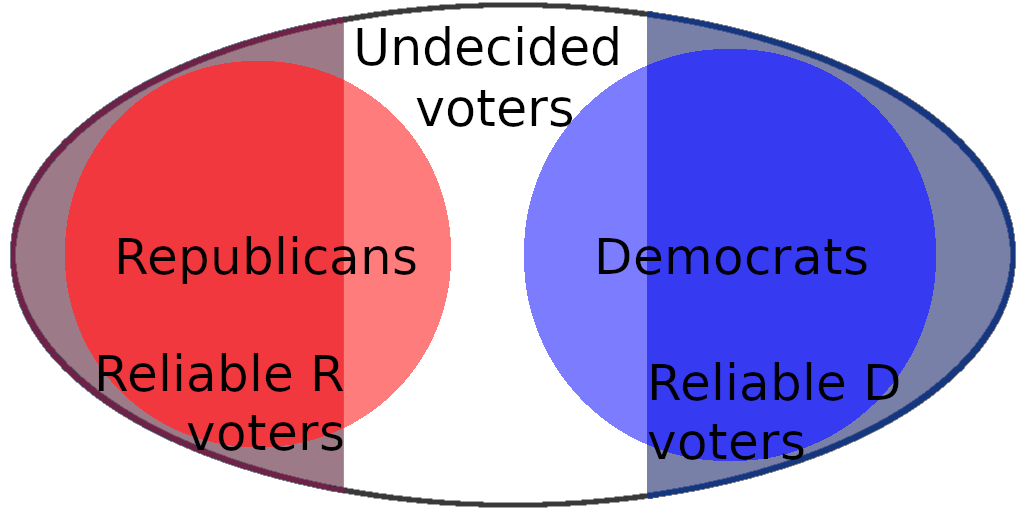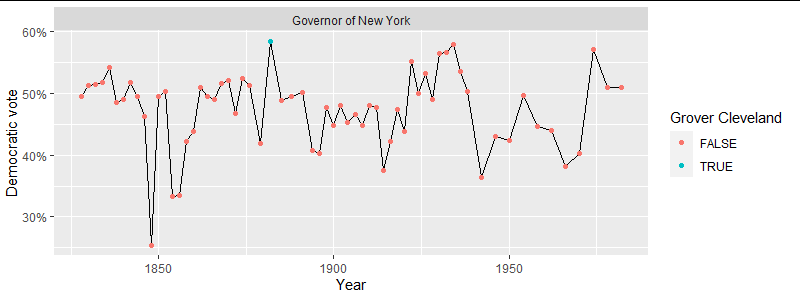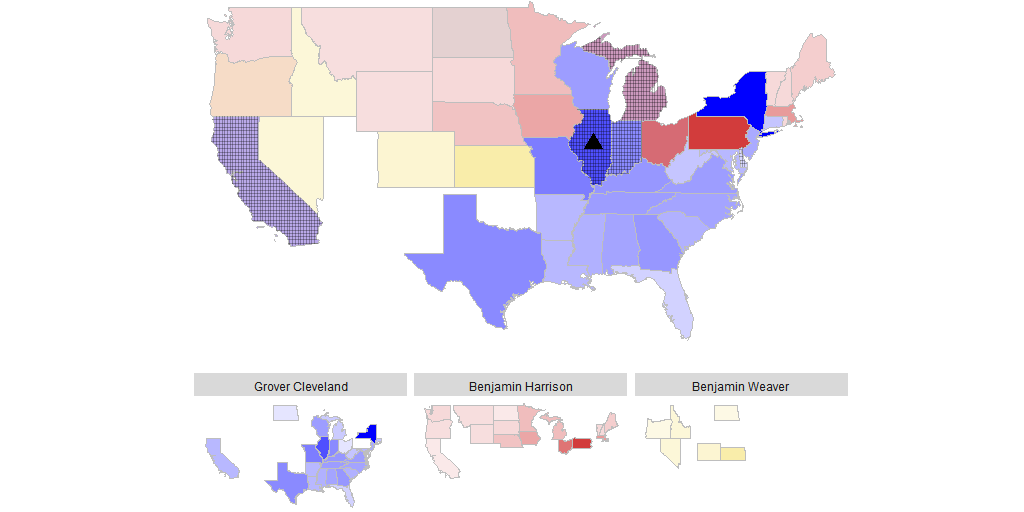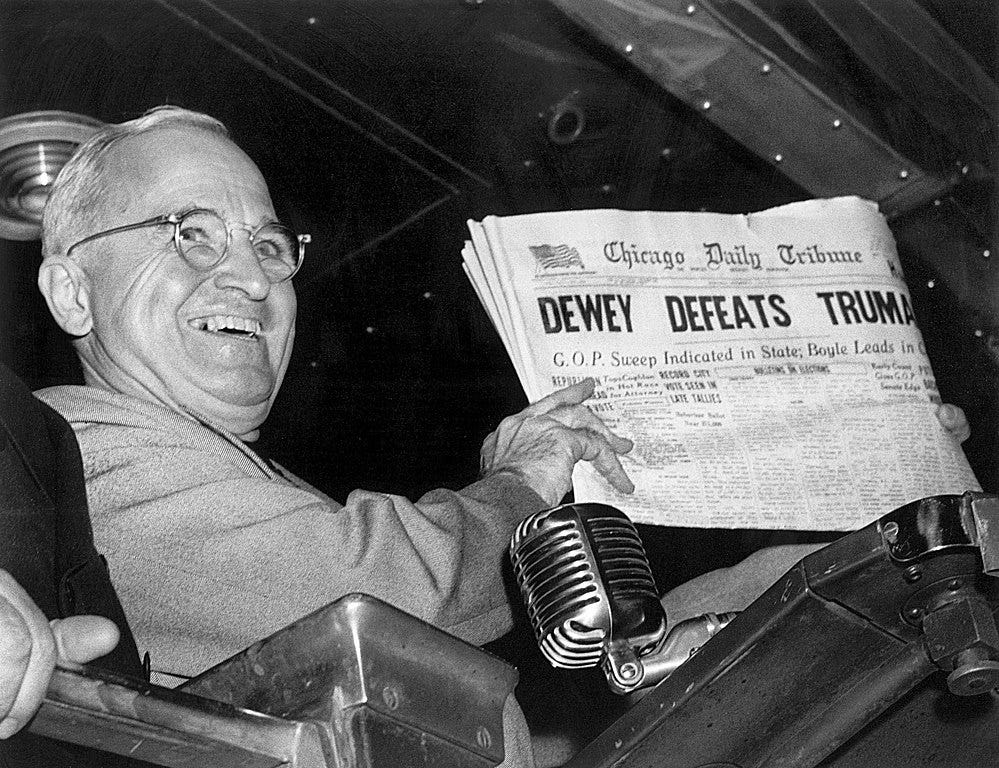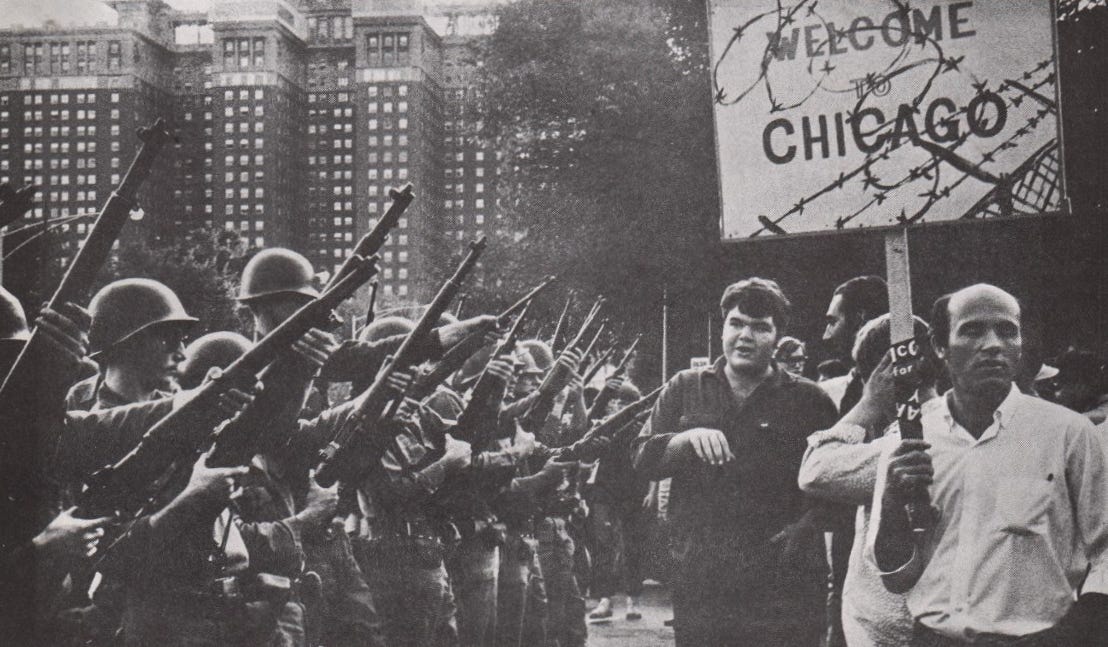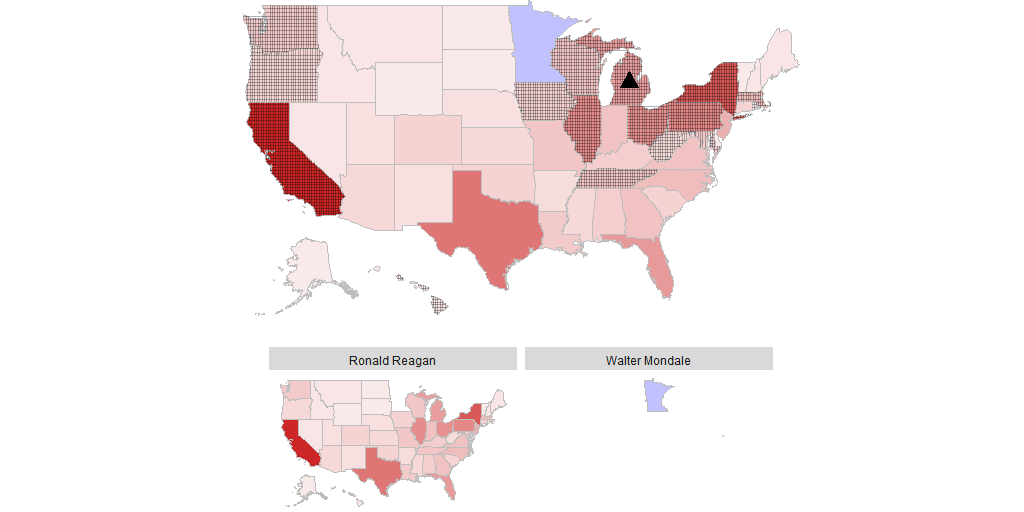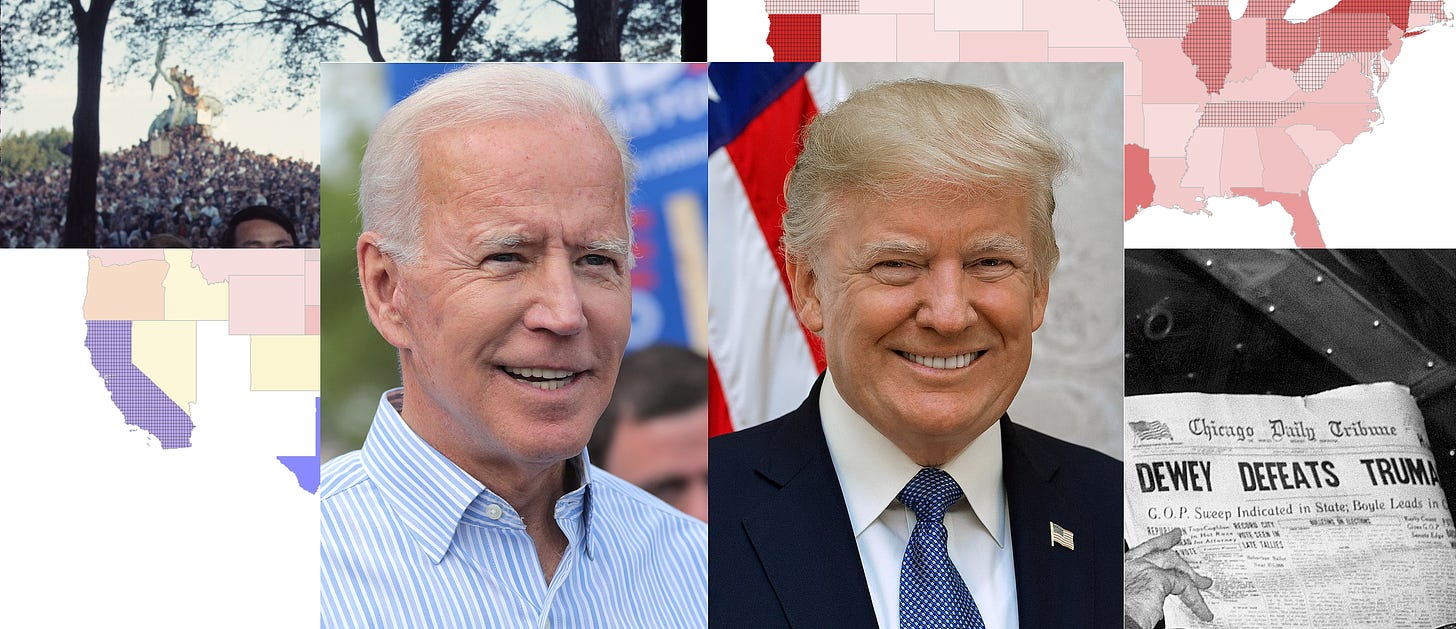
My book on the Electoral College discusses all fifty-nine presidential elections from 1788 to 2020 because I wanted to have a broad and historically-grounded perspective on how the Electoral College works. Today, I want to talk about which presidential elections I’ve been thinking about as the 2024 election draws close.
Naturally, this includes recent elections - Trump and Biden are familiar figures in American politics - but also the elections of 1892, 1948, 1968, and now 1984. Each of these elections has key lessons to teach us about this election and this moment, both in terms of political strategy and in terms of expectations.
From a historical perspective, I think Biden’s chances of victory against Trump are widely underrated; relatedly, the importance of anti-Biden dissent is overrated while the importance of anti-Trump dissent is overrated; and the consequences of abandoning Biden or Trump as nominee are vastly underrated.
The big picture
Right now, the big picture is that both Trump and Biden are polling consistently under 50% of the electorate. Neither candidate is particularly popular right now, which is a situation similar to 2016.
Rematch elections tend to have similar results, and this should make the election relatively easy to predict.
Echoes of 1892
Only one former president has ever returned from office: Grover Cleveland. This happened in an interesting way:
1884: Grover Cleveland won a plurality of 48.8% of the vote.
1888: Grover Cleveland won a plurality of 48.6% of the vote.
1892: Grover Cleveland won a plurality of 46.0% of the vote.
Grover Cleveland won the popular vote three times. Prior to his first presidential run, he also won the popular vote by an exceptional margin when running for governor of New York:
Donald Trump is not Grover Cleveland. However, like Grover Cleveland, his support has been relatively stable thus far: He lost the popular vote twice with 46.1% and then 46.8% of the vote. His current polling average is actually below 46%, with a large undecided share of the population; it is quite likely that he will earn less than 47% of the vote in 2024, though it remains possible for him to win with as little as 46% of the vote. As in 1892, winning with 46% of the vote requires that a significant share of voters choose to reject both parties.
Candidates rarely go from losing the popular vote to winning it. William Jennings Bryan, another three-time candidate, went from 46.7% of the vote to 45.5% to 43.1%. His first two contests were matches against the same opponent (William McKinley). The history of rematches suggests that Donald Trump’s level of support in 2024 should be very similar to his level of support in 2016 and 2020.
The big question is this: What about Joe Biden? How much of his 2020 support can he retain? Will voters choose to support him against Trump - or will they abandon him, voting for third-party candidates, leaving the top line of their ballot empty, or holding their nose to vote for a candidate they detest?
1948 and the Dixiecrat rebellion
In 1948, segregationists from the Southern wing of the Democratic Party stormed out of the Democratic National Convention and nominated their own presidential candidate, Strom Thurmond. At this point in time, the segregationists of the Solid South were not swing voters in the two-party system. They were politically powerful, but represented the views of a small minority of voters whose perspective was (at the time) completely excluded from the Republican Party.
Biden has also faced loud and extremely passionate criticism from a small segment of the American population that rallied in support of Gaza following Hamas’s attacks on October 7th, 2023 and dislikes Biden’s moderate position on Israel. Like the passionate segregationists, this segment makes up a minority of the Democratic Party and is not welcome in the Republican Party; and supporting Donald Trump on behalf of Palestinian interests makes as much sense as supporting Thomas E. Dewey on behalf of segregationists.1
While under fire from segregationists, Harry Truman’s approval rating fell to under 40%, a figure that seems all the more impressive when we put it in the context of the fact that his peak approval rating had been north of 80%. Polling generally showed Truman substantially behind, sometimes thought to be an artifact of socioeconomic factors and uneven adoption of new technologies.2 Compounding this factor, journalists and the educated elites that news editors generally rub elbows with disliked Truman, mostly for reasons related to class, identity, and culture rather than partisan affiliation.
Today, as in 1948, a substantial share of partisans whose natural home remains in the Democratic Party overtly and loudly disparage Biden, demanding that he abandon principles that enjoy bipartisan popularity, and pollsters struggling with uneven adoption of new communications technologies find that they are having trouble reaching representative samples. Meanwhile, journalists and the educated elites that news editors generally rub elbows with dislike Biden, mostly for reasons related to class, identity, and culture rather than partisan affiliation.
Sound familiar to you? It sounds familiar to me.
The Democratic National Convention in Chicago
This year, Democrats are holding their national convention in Chicago. One of the most famous Democratic National Conventions happened in Chicago in 1968. It wasn’t pretty, and it wasn’t pretty for an assortment of reasons: Incumbent Lyndon B. Johnson stepped away from running again, one of the arguable frontrunners (Robert F. Kennedy) was assassinated, and then the delegates at the convention decided to nominate Hubert Humphrey, who hadn’t participated in any of the state primary contests.
Old conservative Southern Democrats were angry because Hubert Humphrey was the firebrand anti-segregationist who set the 1948 convention on fire. Young liberal Democrats were angry because Hubert Humphrey supported the Vietnam War. There were protests. There were riots. Segregationists ran their most successful third-party bid yet; with a geographically diffuse base of support, Hubert Humphrey lost decisively in the Electoral College, although the actual popular vote was quite close.3
Today, two separate groups seem intent on trying to make Chicago 2024 a repeat of Chicago 1968: Leftist protestors who want to force the Democratic Party to pivot hard to the left (the war in Gaza being one of the loudly focal subjects) and elites who want to force the Democratic Party to abandon their elected nominee in favor of holding the first brokered convention since 1968.
The 1984 debate
The first presidential debate was held last week. Both candidates showed visible signs of aging poorly, offering answers that sometimes veered into confusion and incoherence and sometimes were completely unrelated to the topic at hand. However, they were understandable most of the time, and reading the transcript shows little difference in levels of incoherence between the two. (Full debate transcript available here.)
Biden reportedly had a cold; he was quieter and visibly less energetic, particularly during the first half of the debate. (During the second half, Biden became more energetic and Trump became less energetic, narrowing the gap in energy levels substantially.)
In 1984, an aging Reagan showed signs of age, forgetfulness, and incoherence in the debate. Some scholars have argued that these were the early signs of Alzheimer’s on display; some have said this was normal age-related decline in performance. After the first debate, pundits were shocked, and declared Reagan’s campaign dead in the water… and then Reagan went on to win the most lopsided electoral victory of the last half-century.
Concerns over Reagan’s age were legitimate, as are concerns today over the age of Trump and Biden, both of whom are older than Reagan was in 1984. However, Biden having a poor debate night during which he showed more signs of age than usual is not likely to have (by itself) any major impact on voters’ choices. Instead, what is important are the secondary effects; if Democrats force Biden out, it is likely to have disastrous consequences.
Recap and review
At present, Donald Trump has led in polling for most of the year, but it is still several months before the election, and polling indicates that there are a large number of voters who are not yet ready to say that they will support either candidate.
There are good fundamental reasons to expect that Donald Trump will struggle to win more than 46% of the vote; there are also good reasons to believe that, between the dislike he has attracted from the pro-Palestine left, journalists, and elites, media coverage (and, for that matter, polling), it is easy to underestimate Biden’s support at the end of the day in the general election.
While both major party nominees are, frankly, too old to make it advisable to elect them to the position of President of the United States of America, neither party is in a position where they are likely to win by throwing out the results of their own presidential primaries. The balance of the election rests in the hands of swing voters who are not well understood by the reliable partisans who dominate both “blue” and “red” flavors of media.
Dewey was a New York Republican. His platform included support for a federal anti-lynching law, abolition of poll taxes, opposition to racial segregation in the armed forces, and civil rights legislation to support equal opportunity regardless of race. His ticket and platform was total anathema to segregationists, who found him no more palatable than Truman.
His running mate, Californian Earl Warren, later became the chief justice of the Supreme Court from 1953 to 1969; he authored the Brown v. Board decision in 1954 and was instrumental in numerous civil rights cases. Another repeat loser of the popular vote, Dewey earned 45.9% of the vote in 1944 and 45.1% of the vote in 1948.
Household adoption of telephones was uneven, so telephone polling skewed heavily to higher-class households, which skewed poll results in favor of Dewey.
The popular vote margin was under 1%.



